The ultimate guide to corn flake processing line in 2024
Introduction
Welcome to the ultimate guide to corn flake processing lines in 2024. As experts in the field of industrial food processing machinery, we understand the importance of staying updated with the latest advancements in technology and production methods. In this comprehensive guide, we will explore the significance of corn flake processing lines in the food industry, delve into the innovative technologies driving their evolution, and anticipate emerging trends shaping the landscape of corn flake production.
Corn flakes have been a breakfast staple for decades, loved by millions around the world for their crunchy texture and delicious flavor. Behind every bowl of corn flakes lies a sophisticated process involving state-of-the-art machinery and precision engineering. The corn flake processing line is the heart of this operation, encompassing a series of interconnected machines designed to transform raw corn kernels into the iconic breakfast cereal we all know and love.
In recent years, advancements in technology have revolutionized the way corn flakes are produced, leading to greater efficiency, consistency, and quality in the final product. From automated ingredient mixing and extrusion to continuous baking and packaging, modern corn flake processing lines are equipped with cutting-edge features that streamline the production process and elevate the standards of cereal manufacturing.
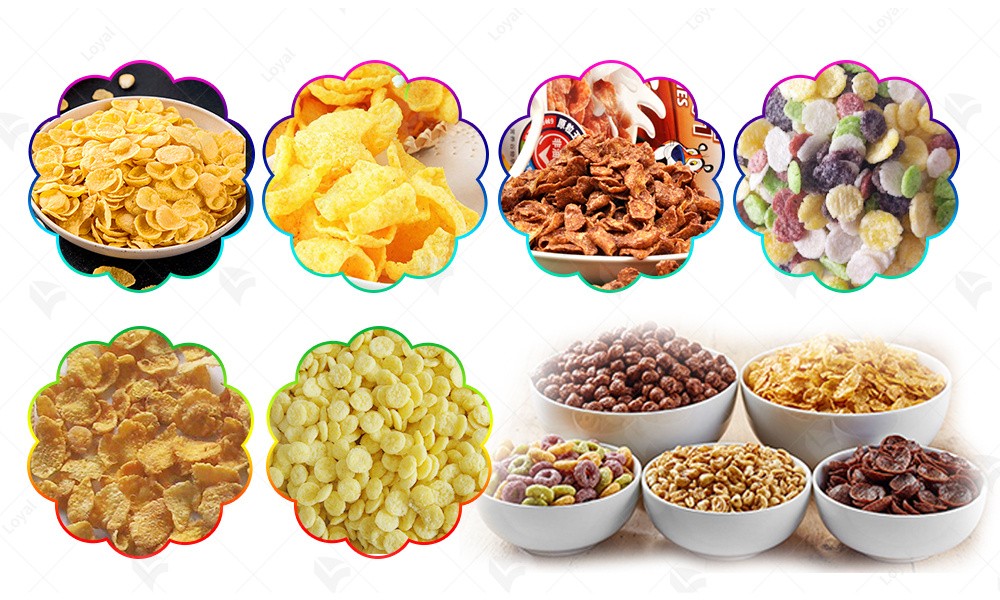
Forecast of Emerging Trends and Progress in Corn Flake Processing Production Lines
As we venture into 2024, the landscape of corn flake processing production lines is poised for remarkable advancements and innovations. Let's delve into the forecast of emerging trends and progress that we can anticipate in the coming year.
1. Integration of Artificial Intelligence (AI) and Automation:
The adoption of artificial intelligence (AI) and automation is expected to revolutionize corn flake processing lines. AI-driven algorithms will optimize production processes, enhancing efficiency and reducing waste. Automated systems will streamline operations, from ingredient mixing to packaging, ensuring consistent quality and minimizing human error.
2. Enhanced Customization Capabilities:
Consumers are increasingly seeking personalized food experiences, and corn flake manufacturers are poised to meet this demand. In 2024, we anticipate the integration of advanced customization capabilities in processing lines. Manufacturers will be able to offer a wide array of flavors, textures, and shapes to cater to diverse consumer preferences, thanks to adaptable machinery and flexible production processes.
3. Sustainable Practices and Eco-Friendly Solutions:
Environmental sustainability will continue to be a focal point in corn flake processing. In the year ahead, we forecast an increased emphasis on sustainable practices and eco-friendly solutions. From energy-efficient processing methods to the use of biodegradable packaging materials, manufacturers will prioritize reducing their environmental footprint while meeting consumer expectations for environmentally conscious products.
4. Digitalization and Data-Driven Insights:
The digital transformation of corn flake processing lines will accelerate in 2024. Digitalization initiatives will enable real-time monitoring of production parameters, predictive maintenance scheduling, and data-driven decision-making. IoT sensors and connected devices will provide valuable insights into equipment performance, optimizing production efficiency and ensuring consistent product quality.
5. Focus on Food Safety and Quality Assurance:
As consumer awareness of food safety and quality grows, corn flake manufacturers will intensify their efforts to uphold the highest standards. In the coming year, we anticipate increased investments in food safety technologies and rigorous quality control measures along the production line. From stringent hygiene protocols to advanced contamination detection systems, every aspect of production will be scrutinized to ensure the safety and integrity of corn flake products.
6. Collaboration and Innovation Partnerships:
Collaboration and innovation partnerships will play a pivotal role in driving progress in corn flake processing lines. Manufacturers, technology providers, and research institutions will collaborate to develop groundbreaking technologies and methodologies. These partnerships will foster creativity and accelerate the pace of innovation, leading to the development of next-generation processing solutions that redefine the industry standards.
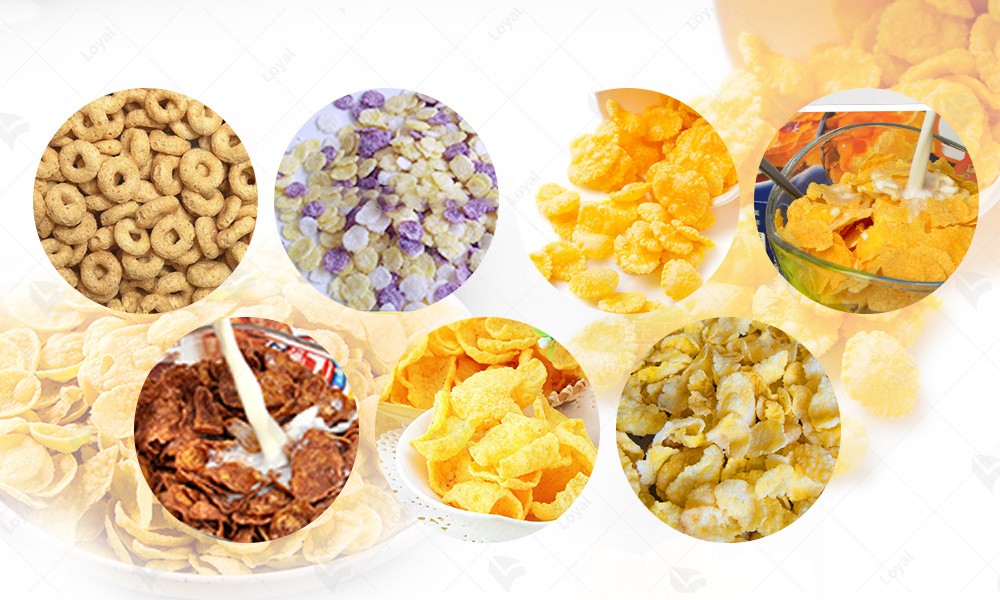
Advanced Technology of Corn Flakes Processing Production Line
1. Automated Ingredient Mixing Systems:
One of the key advancements in corn flake processing lines is the integration of automated ingredient mixing systems. These systems utilize precise measurements and mixing techniques to ensure uniform distribution of ingredients, resulting in consistent taste and texture of corn flakes. Automated mixing reduces human error, increases production efficiency, and enhances product quality.
2. Precision Extrusion Technology:
Precision extrusion technology plays a pivotal role in shaping the corn flakes into their characteristic flat, thin shapes. Advanced extruders equipped with precision control systems can accurately regulate temperature, pressure, and moisture levels during the extrusion process. This precision ensures that each corn flake is uniformly cooked and retains its desired texture and crunchiness.
3. Continuous Baking Processes:
Traditional batch baking methods are being replaced by continuous baking processes in modern corn flake processing lines. Continuous baking allows for a more streamlined and efficient production flow, eliminating the need for frequent start-up and shutdown cycles. This results in higher throughput, reduced energy consumption, and consistent product quality.
4. Real-time Monitoring and Control Systems:
Real-time monitoring and control systems are indispensable tools in modern corn flake processing lines. These systems utilize sensors and data analytics to monitor various parameters such as temperature, moisture content, and product quality throughout the production process. Operators can adjust settings and parameters in real-time to optimize production efficiency and ensure product consistency.
5. Integration of Artificial Intelligence (AI) and Machine Learning:
The integration of artificial intelligence (AI) and machine learning technologies is driving innovation in corn flake processing lines. AI algorithms analyze production data to identify patterns, optimize processing parameters, and predict equipment maintenance needs. Machine learning algorithms continuously improve and adapt based on feedback, leading to enhanced efficiency and productivity.
6. Advanced Packaging Solutions:
In addition to processing technologies, advancements in packaging solutions are also transforming the corn flake industry. Automated packaging systems equipped with advanced sealing and labeling technologies ensure product freshness and integrity. Sustainable packaging materials are gaining traction, aligning with consumer preferences for eco-friendly options.
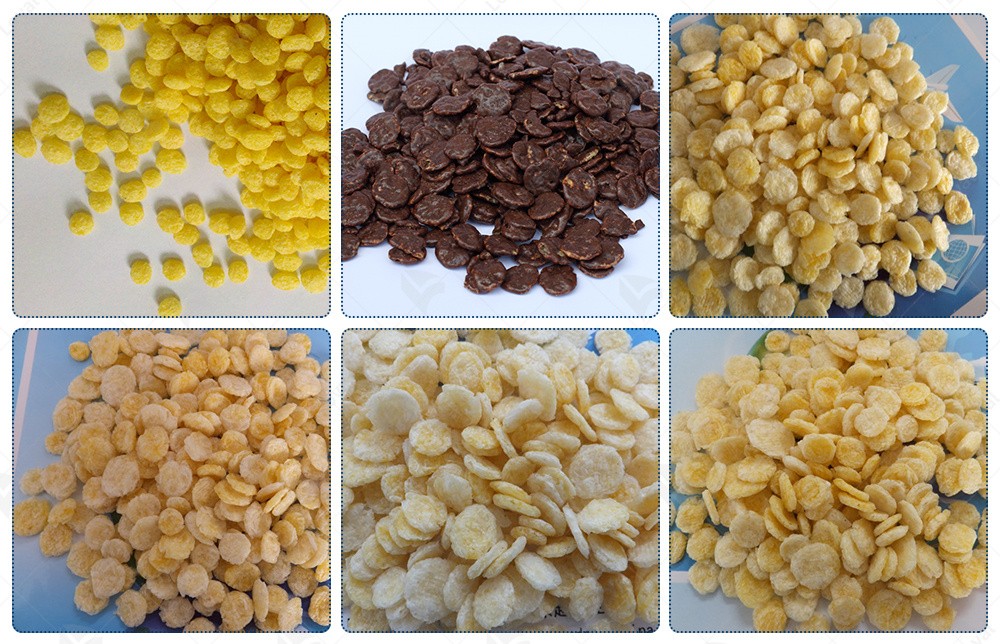
Sustainable Practices in Corn Flake Processing
1. Energy-Efficient Processes:
One of the primary focuses of sustainability in corn flake processing lines is reducing energy consumption. Manufacturers are increasingly investing in energy-efficient equipment and technologies to minimize their carbon footprint. Advanced heating and drying systems utilize innovative heat recovery mechanisms to recycle waste heat, significantly reducing energy consumption during production.
2. Waste Reduction Strategies:
Minimizing waste generation is another key aspect of sustainable corn flake processing. Manufacturers are implementing comprehensive waste reduction strategies throughout the production process. This includes optimizing ingredient usage to minimize excess waste, as well as implementing recycling and composting programs to divert waste from landfills. Additionally, innovative packaging designs are being developed to minimize packaging material usage and reduce overall waste.
3. Eco-Friendly Packaging Materials:
Packaging plays a significant role in the sustainability of corn flake products. Manufacturers are transitioning towards eco-friendly packaging materials that are recyclable, biodegradable, or compostable. This includes utilizing paper-based packaging, compostable plastics, and plant-based materials derived from renewable sources. By adopting sustainable packaging solutions, manufacturers can reduce the environmental impact of their products throughout their lifecycle.
4. Water Conservation Measures:
Water is a precious resource, and sustainable corn flake processing involves implementing water conservation measures. Manufacturers are optimizing production processes to minimize water usage and maximize water recycling and reuse. Advanced water filtration and purification systems are employed to treat process water, ensuring it meets stringent quality standards for reuse in subsequent production cycles. Additionally, rainwater harvesting and wastewater treatment technologies are being utilized to further reduce water consumption and minimize environmental impact.
5. Certification and Compliance:
To demonstrate their commitment to sustainability, many manufacturers are obtaining certifications such as LEED (Leadership in Energy and Environmental Design) and ISO 14001 (Environmental Management System). These certifications attest to their adherence to stringent environmental standards and their ongoing efforts to minimize their environmental footprint. Additionally, manufacturers are ensuring compliance with regulatory requirements and industry guidelines related to sustainability and environmental stewardship.
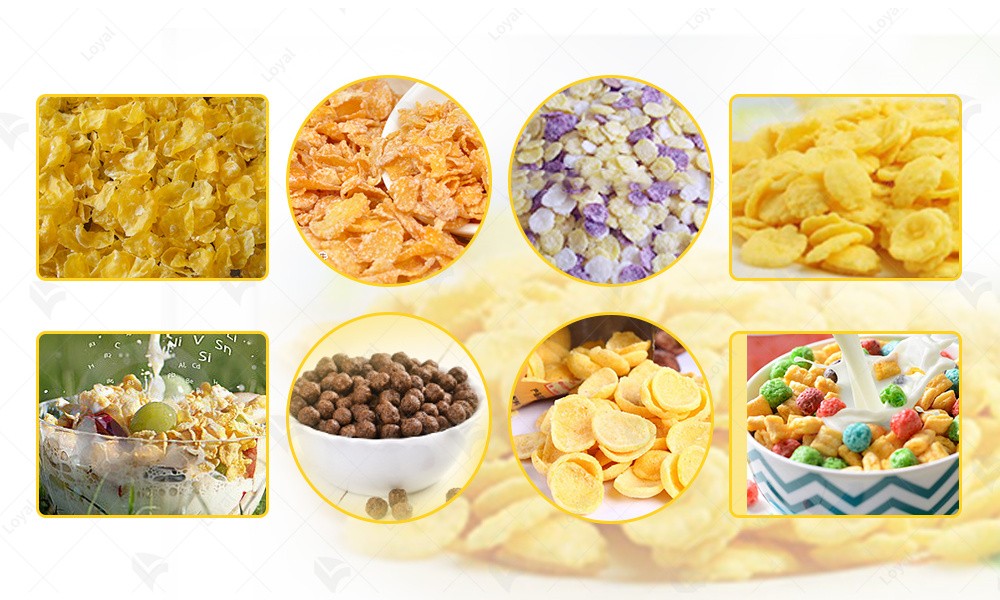
Work Flow of Corn Snacks
1. Raw Material Preparation:
- The work flow of corn snacks begins with the careful selection and processing of high-quality corn flour. This finely ground cornmeal serves as the primary ingredient for creating the base mixture used in snack production.
- Manufacturers prioritize the sourcing of premium corn flour to ensure consistent taste and texture in the final product. Rigorous quality control measures are implemented to assess factors such as moisture content, particle size, and purity.
2. Mixing and Flavoring:
- Once the corn flour is prepared, it is mixed with water and other ingredients to form a dough-like consistency. This mixture serves as the foundation for the creation of various corn snack shapes and textures.
- The versatility of corn snack machines allows for the incorporation of a wide range of flavors and seasonings. From classic salted varieties to more adventurous options like cheese, barbecue, or chili, manufacturers can customize the flavor profile to cater to diverse consumer preferences.
3. Extrusion and Shaping:
- The prepared dough is then fed into the extrusion chamber of the corn snack machine, where it undergoes high pressure and temperature to transform into its desired form.
- Specialized dies and molds are used to shape the extruded dough into familiar corn snack shapes, such as curls, twists, or rings. Precision engineering ensures consistent sizing and texture throughout the production process.
4. Frying or Baking:
- After shaping, the corn snacks enter the cooking stage, where they are either fried in oil or baked in an oven. This step is crucial for achieving the signature crunchiness and golden brown color associated with corn snacks.
- Manufacturers carefully control cooking time and temperature to ensure uniformity and avoid overcooking or burning. Advanced corn snack machines feature precise temperature control and monitoring systems for optimal results.
5. Seasoning and Packaging:
- Once cooked to perfection, the corn snacks undergo a final seasoning process to enhance their flavor profile. This may involve spraying or tumbling the snacks with additional seasoning blends to achieve the desired taste intensity.
- Finally, the seasoned corn snacks are carefully packaged into individual servings or bulk containers, ready to be distributed to eager consumers. Packaging materials are chosen to preserve freshness and extend shelf life while maintaining product integrity.
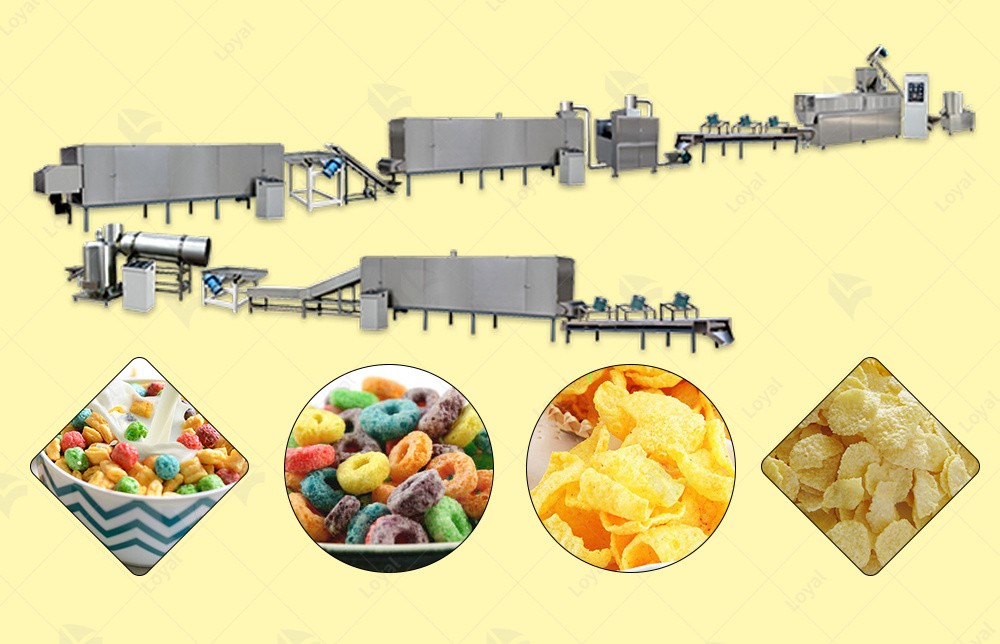
Comparison table between loyal and NP companies in industrial food machinery
|
Aspect |
Loyal Company |
NP Company |
|
Product Range |
Wide range of industrial food machinery, including mixers, extruders, ovens, and packaging equipment. |
Specializes in specific types of food machinery, such as dough sheeters and cookie depositors. |
|
Technology Integration |
Implements advanced technology, such as IoT sensors and automation, to optimize production processes and enhance efficiency. |
Focuses on traditional machinery with limited integration of modern technology. |
|
Customization Options |
Offers extensive customization options to meet the unique needs of clients, including tailored equipment design and specialized features. |
Provides standard machinery models with limited customization capabilities. |
|
Market Presence |
Established presence in both domestic and international markets, with a strong reputation for reliability and innovation. |
Primarily serves domestic markets with limited global reach. |
|
Customer Support |
Provides comprehensive customer support services, including installation assistance, training programs, and ongoing technical assistance. |
Offers basic customer support services, with limited post-sale assistance and technical support. |
|
Sustainability Efforts |
Actively invests in sustainable practices, such as energy-efficient designs and eco-friendly materials, to minimize environmental impact. |
Limited focus on sustainability initiatives, with minimal investment in eco-friendly practices. |
|
Pricing |
Competitive pricing with value-added features and services, catering to a diverse range of clients across various industries. |
Pricing may be lower due to fewer features and customization options, targeting budget-conscious customers. |
|
Reputation |
Well-regarded for high-quality products, innovative solutions, and reliable performance, earning the trust of industry professionals. |
Known for offering affordable options but may lack the reputation for advanced technology and customization capabilities |
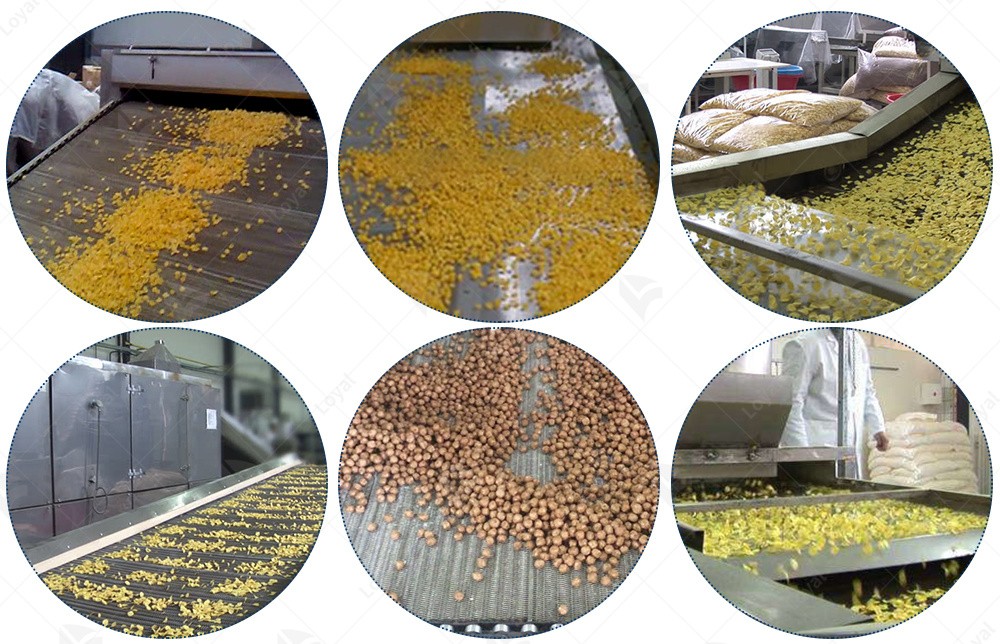
Integration of Digitalization and Data Analysis
In the ever-evolving landscape of food processing, the integration of digitalization and data analysis has become increasingly prevalent, revolutionizing the operation and management of corn flake processing lines. Let's explore how these technological advancements are reshaping the industry in 2024.
Digitalization has ushered in a new era of efficiency and precision in corn flake processing lines. With the implementation of IoT sensors, every aspect of the production process is meticulously monitored in real-time. From ingredient mixing to extrusion and baking, data is collected at every stage, providing valuable insights into performance and quality control.
The cloud computing revolution has further enhanced the capabilities of corn flake processing lines. By storing vast amounts of data on remote servers, manufacturers can access information from anywhere, at any time. This facilitates seamless collaboration between teams and enables quick decision-making based on real-time data analysis.
One of the most significant benefits of digitalization in corn flake processing lines is predictive maintenance. By analyzing data patterns and machine performance metrics, potential issues can be identified and addressed before they escalate into costly downtime. This proactive approach not only minimizes disruptions but also prolongs the lifespan of equipment, optimizing overall efficiency and productivity.
Data analysis plays a crucial role in optimizing production processes and ensuring product consistency. By harnessing big data analytics, manufacturers can identify trends, patterns, and anomalies in production metrics. This allows for continuous process improvement and fine-tuning, resulting in higher-quality corn flakes and reduced waste.
Moreover, the integration of digitalization and data analysis enables manufacturers to meet the increasing demand for customization and personalization. By analyzing consumer preferences and market trends, companies can tailor their products to specific demographics, offering a diverse range of flavors, textures, and packaging options.
In conclusion, the integration of digitalization and data analysis is revolutionizing corn flake processing lines in 2024. By harnessing the power of technology and data, manufacturers can achieve unprecedented levels of efficiency, quality, and customization, ensuring their competitiveness in the dynamic food processing industry.
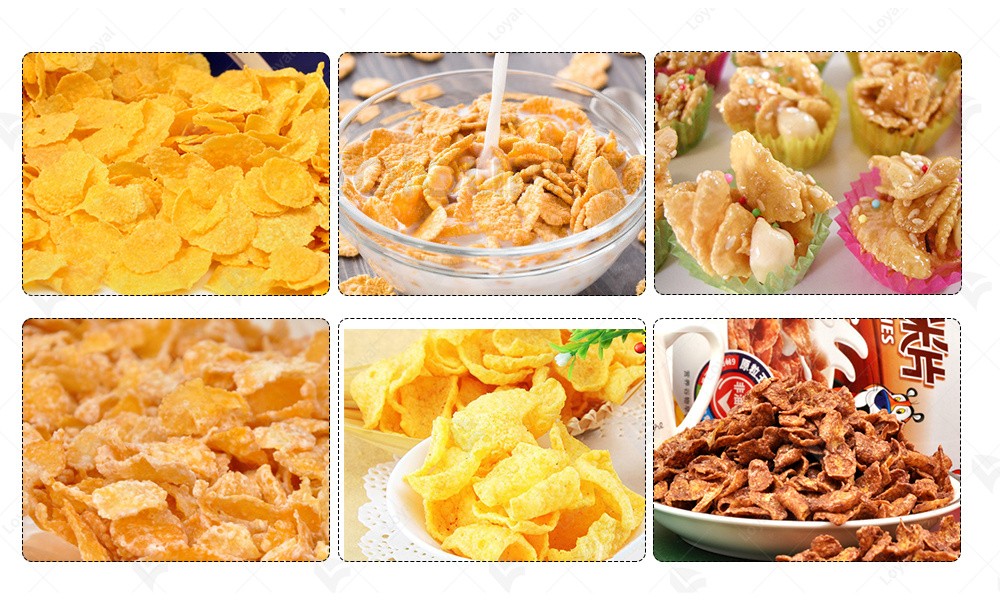
Post-Maintenance Guide for Corn Flake Processing Line
1. Regular Inspection and Cleaning:
Regular inspection and cleaning are fundamental for maintaining the optimal performance of your corn flake processing line. Begin by conducting thorough visual inspections of all components, including the mixer, extruder, oven, and packaging equipment. Look for any signs of wear, damage, or debris accumulation. Use suitable cleaning agents and equipment to remove any buildup or residue, ensuring that all parts remain clean and free from contamination.
2. Lubrication and Calibration:
Proper lubrication and calibration are key to preventing premature wear and ensuring the smooth operation of your corn flake processing line. Regularly lubricate moving parts, such as bearings, gears, and conveyor belts, using manufacturer-recommended lubricants to minimize friction and reduce the risk of breakdowns. Additionally, calibrate sensors and control systems periodically to maintain accuracy and consistency in processing parameters, ensuring that your processing line continues to produce high-quality corn flakes efficiently.
3. Troubleshooting and Problem-Solving:
Despite regular maintenance, issues may arise with your corn flake processing line. Develop a systematic approach to troubleshooting to identify and address common problems promptly. Keep detailed records of maintenance activities and performance metrics to facilitate troubleshooting and root cause analysis. Establish clear communication channels with equipment suppliers or service providers for timely assistance and resolution of technical challenges, minimizing downtime and maximizing productivity.
4. Safety Measures and Compliance:
Ensuring the safety of operators and compliance with regulatory requirements is paramount in corn flake processing line maintenance. Provide comprehensive training for operators on proper machine operation, safety protocols, and emergency procedures. Conduct regular risk assessments and safety audits to identify potential hazards and implement preventive measures. Stay updated on industry regulations and compliance standards to ensure adherence to food safety and quality guidelines, safeguarding both your employees and your business reputation.
5. Performance Optimization and Upgrades:
To stay competitive in the food processing industry, consider opportunities for performance optimization and upgrades for your corn flake processing line. Stay informed about the latest advancements and best practices through engagement with industry experts and equipment manufacturers. Explore options for software updates, equipment upgrades, or process refinements to enhance efficiency and reliability. Additionally, consider investing in additional features or accessories, such as automated cleaning systems or predictive maintenance technologies, to further improve your processing line's performance and longevity.
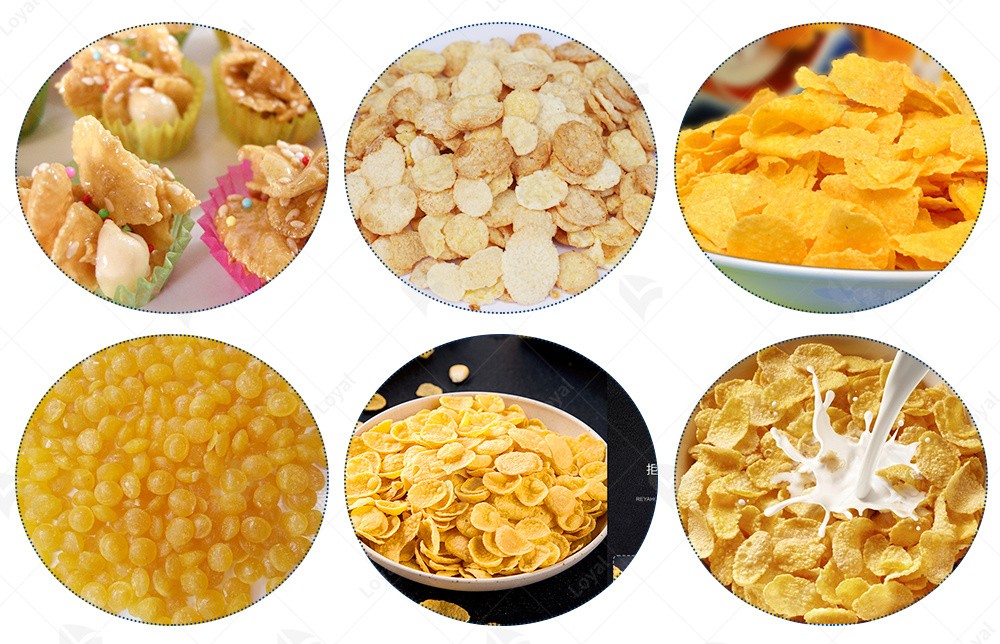
Reference materials
1. Food Engineering Magazine
Website: [https://www.foodengineeringmag.com/]
2. Food Processing Magazine
Website: [https://www.foodprocessing.com/]
3. Institute of Food Technologists (IFT)
Website: [https://www.ift.org/]
4. American Society of Agricultural and Biological Engineers (ASABE)
Website: [https://www.asabe.org/]
5. European Federation of Food Science and Technology (EFFoST)
Website: [https://effost.org/]